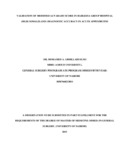| dc.description.abstract | Background: In the diagnosis of Acute appendicitis (AA), its clinical supported by laboratory and radiologic investigation. Confirmatory (Gold standard) test is histopathology. There is need for an easily available protocol pre-operatively to improve the analysis of severe appendicitis. Numerous scoring systems have been introduced in the literature. The Modified Alvarado scoring (MAS) system is one of the validated tools used in the diagnosis of acute appendicitis in several centers; it has not been validated in the Hargeisa Group Hospital.
Objective: To establish diagnostic validity of the modified Alvarado score in the diagnosis of acute appendicitis at the Hargeisa Group Hospital (HGH).
Methodology: This was a prospective cross sectional study carried out for seven months at Hargeisa Group Hospital general surgical unit. Patients with possible acute appendicitis who met the inclusion criteria were included. They were scored using the MAS system, and were categorized into 3 groups. Group A: patients scoring 7 and above, Group B: patients with a score of 4-6, and Group C: patients with a score of less than 4. Further investigation with ultrasound was performed in Group B. Those having ultrasonic features of appendicitis were operated on; those not having ultrasonic features of appendicitis were observed for at least 48hours. If they improved, they were followed up for 7 days as those in group C. In order to verify the diagnosis, confirmation was based on histopathology. Data was collected in a structured pretested questionnaire. Statistical analysis was performed using the statistical package for social sciences (STATA 12/SPSS 21.0). The sensitivity, specificity, positive predictive value and negative predictive value of the modified Alvarado score, and the MAS combined with US in acute appendicitis were determined. Graphs, tables and pie charts were employed for results presentation.
Results: In the seven month period from March 2016 to September 2016, 100 patients were studied . The male to female ratio was 1.2:1 the peak incidence of AA was in the third decade with a mean age of 31.7 years. The sensitivity, specificity, PPV and NPV values of the diagnostic protocol were 100%( 95% CI, 96.2.5-100*), 50 %( 95% CI, 18.7 – 81.3), 94.7%( 95% CI, 88.1 – 98.3) and 100 % (95% CI, 47.8 – 100*) respectively, where (*) is one sided 97.5% CI. The calculated crude negative appendectomy rate with the protocol factored in was 10%. The overall accuracy of the protocol in the diagnosis of acute appendicitis was 95%.
Conclusion: The Modified Alvarado Score is a noninvasive, secure analytical procedure and are basic, quick, consistent & repeatable apparatus to utilize in emergency units to part in acute appendicitis. It can aid clinicians in this setup specially juniors to diagnose appendicitis. This study suggests MAS application in order to increase the diagnostic sureness of clinical examination in diagnosis of AA especially by junior doctors and interns in HGH setting. | en_US |
| dc.description.department | a
Department of Psychiatry, University of Nairobi, ; bDepartment of Mental Health, School of Medicine,
Moi University, Eldoret, Kenya | |



